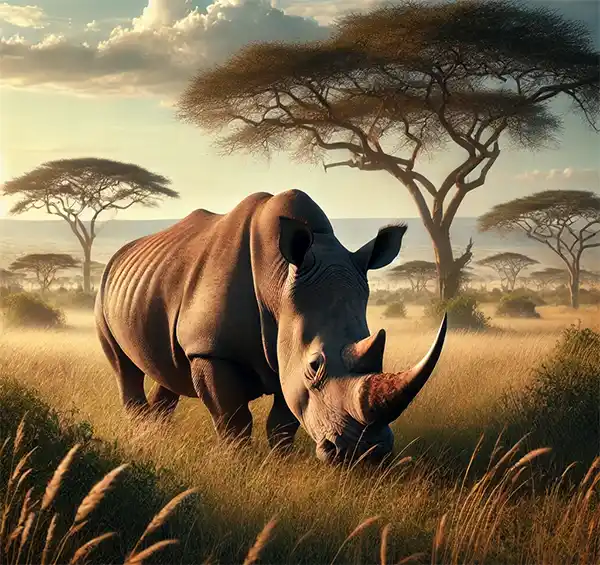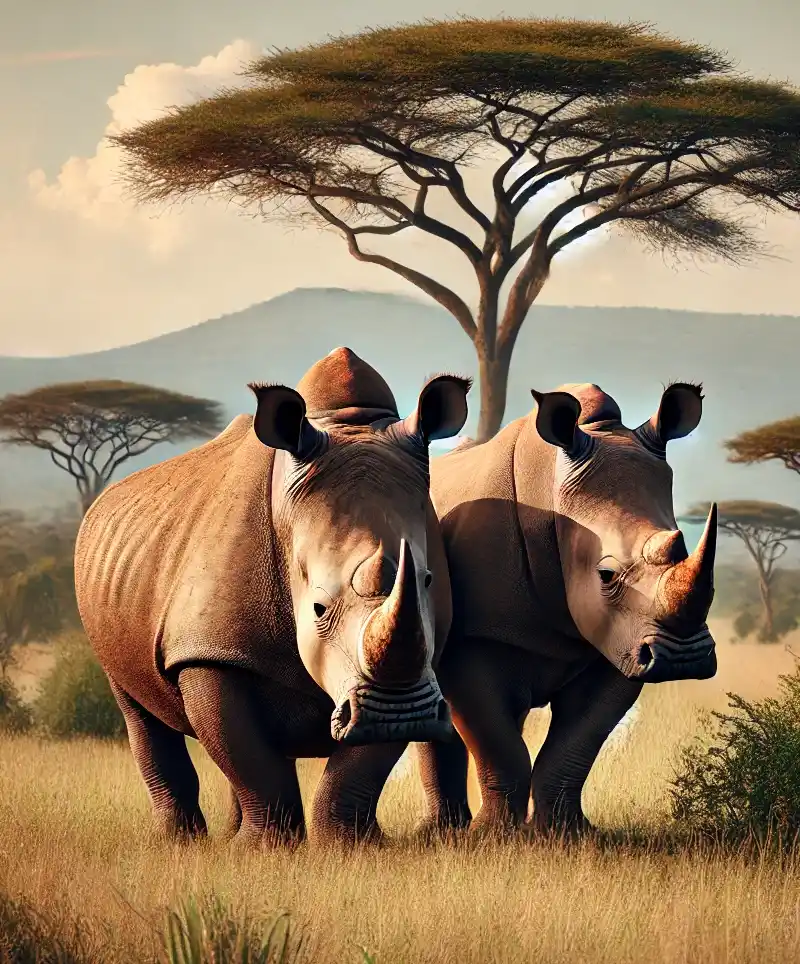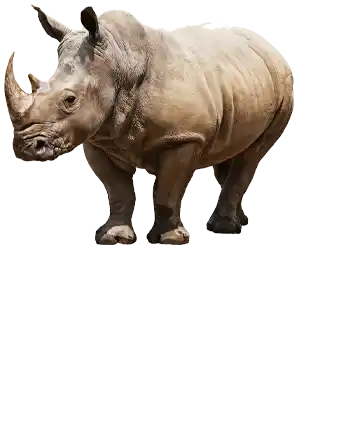Honoring the Thunderous Beasts of the Earth
Every year on September 22nd, we celebrate World Rhino Day, a global event dedicated to raising awareness about one of the planet's most majestic, powerful, and misunderstood creatures—the rhinoceros. With their armor-like skin, signature horns, and surprisingly gentle personalities, rhinos have been stomping around the earth for millions of years. Let’s take a closer look at these magnificent animals, how they’ve evolved, and why they deserve more than just a day in the spotlight.
From Ancient Giants to Modern-Day Tanks
It’s hard to believe that the mighty rhinoceros, often described as a living tank, descended from an animal that looked more like a furry tapir than a prehistoric bulldozer. Rhinos belong to a group of odd-toed ungulates, which also includes horses and tapirs, and their earliest ancestors roamed the Earth around 50 million years ago.
 One of their distant relatives, known as Hyrachyus, was a small, forest-dwelling herbivore that wouldn’t exactly win any awards for "Most Likely to Evolve Into a Rhino." Over time, as the climate shifted and grasslands expanded, some of these creatures developed thicker skin, larger bodies, and eventually, the horns that we associate with modern rhinos. Fast forward a few million years, and you’ve got the woolly rhinoceros, which wandered the Ice Age alongside woolly mammoths. Imagine a rhino in a fur coat—how’s that for a fashion statement?
One of their distant relatives, known as Hyrachyus, was a small, forest-dwelling herbivore that wouldn’t exactly win any awards for "Most Likely to Evolve Into a Rhino." Over time, as the climate shifted and grasslands expanded, some of these creatures developed thicker skin, larger bodies, and eventually, the horns that we associate with modern rhinos. Fast forward a few million years, and you’ve got the woolly rhinoceros, which wandered the Ice Age alongside woolly mammoths. Imagine a rhino in a fur coat—how’s that for a fashion statement?
Five Species, One Global Stage
Today, there are five species of rhinoceros, and each one brings something unique to the table (besides a weight range of one to three tons).
- White Rhino: The largest of the bunch, white rhinos actually aren’t white at all. Their name comes from a misinterpretation of the Dutch word “wijde,” which means “wide” and refers to their broad mouths. These massive grazers enjoy leisurely meals of grass, followed by naps in the sun.
- Black Rhino: Don’t let the name fool you—black rhinos aren’t particularly black either. They tend to be more solitary and have a pointed upper lip, which they use like a finger to grab leaves and twigs. If rhinos were superheroes, black rhinos would be the stealthy loners with a mysterious edge.
- Indian Rhino: Sporting one large horn and skin that looks like it's been pieced together by a blacksmith, the Indian rhino could easily be mistaken for a creature out of an ancient myth. They love to wallow in muddy ponds, and who can blame them? Mud baths are good for the skin!
- Javan Rhino: Critically endangered and shy to the point of invisibility, the Javan rhino is like the celebrity who refuses to attend award shows. Found only in a small corner of Indonesia, spotting one of these elusive creatures is like winning the wildlife lottery.
- Sumatran Rhino: These are the smallest rhinos (though still larger than your average sedan), and they happen to be covered in a light coat of hair. They're essentially the distant cousin who never got over their woolly rhinoceros roots.
Rhinos are famous for their horns, which—surprise!—aren’t made of bone. They’re composed of keratin, the same material that makes up human hair and fingernails. So, in a way, a rhino’s horn is like a really intense manicure. Unfortunately, this remarkable feature has also led to their greatest threat: poaching.
Beyond their horns, rhinos have an arsenal of amazing abilities. Despite their massive size, rhinos can run at speeds of up to 35 miles per hour—faster than an Olympic sprinter. And while they might seem clumsy, they’re surprisingly agile, capable of making sharp turns when needed. Just imagine a three-ton ballerina pirouetting through the savannah. Graceful, right?
Rhinos also have excellent hearing and an extraordinary sense of smell, but their eyesight? Not so much. A rhino might not see you standing still from a few yards away, which might explain why they sometimes charge at nothing in particular. It’s a little embarrassing, but who’s going to tell them?
How to Celebrate World Rhino Day
So, how can you honor these wonderful creatures on World Rhino Day? It’s not every day you get to celebrate an animal that has existed since the time of woolly mammoths and saber-tooth tigers. Here are a few ideas:
- Throw a Rhino-Themed Feast: Channel your inner rhino and enjoy a meal fit for one of these mighty herbivores. Pile your plate with leafy greens, fruits, and veggies. You could even make a rhino-shaped cake, because who doesn’t love a cake shaped like a rhinoceros?
- Take a Mud Bath: Rhinos are known for their love of wallowing in mud to cool off and protect their skin from the sun. You might not have a watering hole nearby, but a mud mask or a day at the spa could do the trick.
- Adopt a Rhino: While you can’t exactly keep a rhino in your backyard (local zoning laws frown upon it), many wildlife organizations offer symbolic rhino adoptions. Your contribution will help protect these gentle giants from poaching and habitat loss.
- Share the Rhino Love: Spread awareness about rhino conservation by sharing facts, photos, and information on social media. The more people know about these incredible animals, the better chance we have of keeping them around for future generations.
Rhino Conservation
Conservation efforts surrounding rhinos are nothing short of a race against time. Poaching, habitat loss, and the illegal wildlife trade have driven some species of rhinos to the brink of extinction, making it crucial to act swiftly and strategically to protect these majestic creatures. The battle to save rhinos has been ongoing for decades, but the fight is far from over. Here's a closer look at the key issues facing rhino conservation, the efforts being made, and some success stories that give hope for the future.
The Threat of Poaching: At the heart of the rhino conservation crisis lies the illegal demand for rhino horns, primarily driven by markets in Asia. Rhino horns have long been prized in traditional medicine, where they are falsely believed to possess healing properties for ailments ranging from fevers to cancer. Despite modern science proving that rhino horns are made of keratin—the same substance as human hair and fingernails—this myth has persisted for centuries. As a result, the black market value of rhino horns has soared to astronomical levels, making poaching a lucrative, albeit illegal, business.
Poachers are well-equipped and highly organized, often using helicopters, night vision technology, and tranquilizers to track and kill rhinos. In many cases, the horns are brutally hacked off while the animals are still alive, leaving them to die from their injuries. This gruesome practice has devastated rhino populations across Africa and Asia, pushing several species to the edge of extinction.
Habitat Loss: While poaching grabs most of the headlines, habitat loss is an equally significant threat to rhinos. Human expansion, agriculture, and infrastructure projects have led to the destruction of large swaths of rhino habitats, particularly in Asia. As natural habitats are fragmented and degraded, rhinos are forced into smaller, more isolated pockets of land, where they are more vulnerable to poaching and other dangers. This shrinking habitat also leads to increased human-rhino conflicts, where rhinos may inadvertently wander into farms or villages, resulting in injury or death for both humans and rhinos.
In countries like India and Nepal, conservationists have worked to create and expand protected areas to help preserve critical rhino habitats. National parks and wildlife reserves provide safe havens for rhinos, but managing these areas requires constant vigilance and resources to prevent encroachment by human activities.
Anti-Poaching Initiatives: In response to the poaching crisis, a variety of anti-poaching initiatives have been implemented across rhino habitats in Africa and Asia. These include everything from high-tech surveillance systems to old-fashioned boots-on-the-ground patrols by dedicated rangers. In some cases, military-style tactics are employed, with rangers and wildlife officers armed and trained to confront poachers in the field.
Conservation drones have become an increasingly common tool in the fight against poaching. These unmanned aerial vehicles (UAVs) can cover vast areas of terrain, tracking rhinos and other endangered animals while also monitoring for potential poaching activity. Paired with GPS tracking collars placed on rhinos, drones allow rangers to respond quickly when animals are in danger.
Another innovative solution to curb poaching is the dehorning of rhinos. By humanely removing a rhino’s horn (which can grow back over time), conservationists make the animals less appealing to poachers. While this may seem drastic, it’s proven effective in certain regions, significantly reducing poaching incidents where dehorned rhinos are present.
 World Rhino Day isn’t just about admiring these creatures from afar—it’s about recognizing the vital role they play in ecosystems, celebrating their history, and working to ensure their future. Rhinos are ancient, thunderous, and undeniably cool, and the world would be a far less interesting place without them.
World Rhino Day isn’t just about admiring these creatures from afar—it’s about recognizing the vital role they play in ecosystems, celebrating their history, and working to ensure their future. Rhinos are ancient, thunderous, and undeniably cool, and the world would be a far less interesting place without them.
So, as you go about your day on September 22nd, take a moment to appreciate the rhino. They’ve been around for millions of years, and with our help, they’ll be here for millions more. Just don’t try to race one—they’ll win, and you’ll end up feeling very, very slow.
Happy World Rhino Day!
Please Share our Content






 One of their distant relatives, known as Hyrachyus, was a small, forest-dwelling herbivore that wouldn’t exactly win any awards for "Most Likely to Evolve Into a Rhino." Over time, as the climate shifted and grasslands expanded, some of these creatures developed thicker skin, larger bodies, and eventually, the horns that we associate with modern rhinos. Fast forward a few million years, and you’ve got the woolly rhinoceros, which wandered the Ice Age alongside woolly mammoths. Imagine a rhino in a fur coat—how’s that for a fashion statement?
One of their distant relatives, known as Hyrachyus, was a small, forest-dwelling herbivore that wouldn’t exactly win any awards for "Most Likely to Evolve Into a Rhino." Over time, as the climate shifted and grasslands expanded, some of these creatures developed thicker skin, larger bodies, and eventually, the horns that we associate with modern rhinos. Fast forward a few million years, and you’ve got the woolly rhinoceros, which wandered the Ice Age alongside woolly mammoths. Imagine a rhino in a fur coat—how’s that for a fashion statement? World Rhino Day isn’t just about admiring these creatures from afar—it’s about recognizing the vital role they play in ecosystems, celebrating their history, and working to ensure their future. Rhinos are ancient, thunderous, and undeniably cool, and the world would be a far less interesting place without them.
World Rhino Day isn’t just about admiring these creatures from afar—it’s about recognizing the vital role they play in ecosystems, celebrating their history, and working to ensure their future. Rhinos are ancient, thunderous, and undeniably cool, and the world would be a far less interesting place without them.








 "Sláinte!" is a traditional Irish expression used as a toast, equivalent to "Cheers!" in English.
"Sláinte!" is a traditional Irish expression used as a toast, equivalent to "Cheers!" in English.